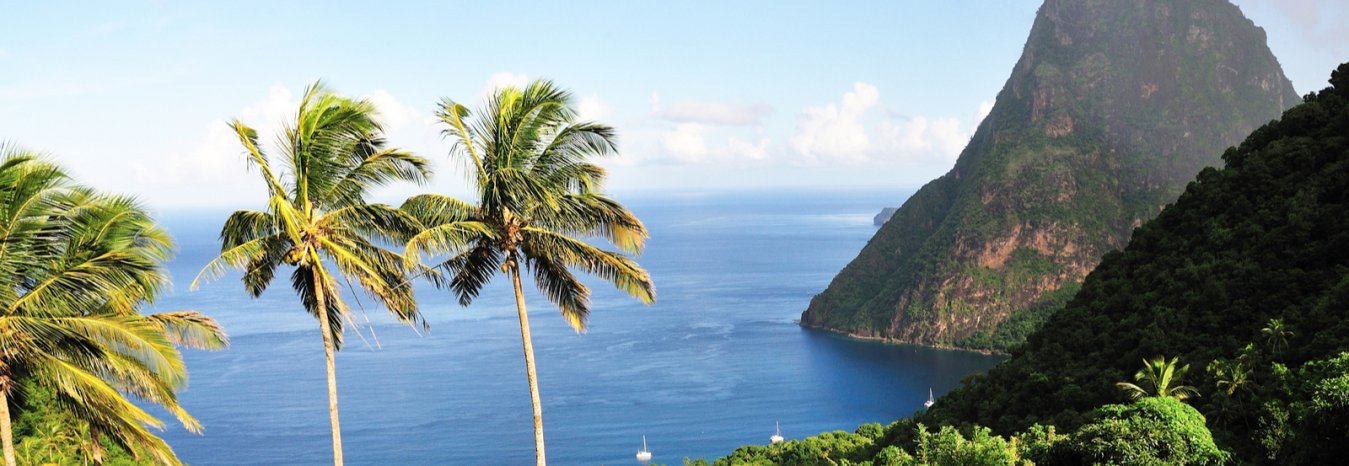
Saint Lucia is a tiny island in the Eastern Caribbean with a couple of dramatically tapered peaks, the Pitons, on its western coast. Saint Lucia is home to volcanic beaches, fishing villages, luxury resorts, and diving sites. The Island is a part of the Lesser Antilles and is located north-west of Barbados, north/north-west of Saint Vincent and south of Martinique. St Lucia is 238.23 square miles in size and has a population of about 174,000 people.
Why you should visit
St. Lucia got it all: Sprawling cream-coloured beaches, lofty mountains and upscale resorts. Start your day off with a morning trek through the famous Piton Mountains, soak up some Caribbean sun at midday along Reduit Beach and watch the stunning sunsets over the Caribbean Sea.
The lush, unspoilt Caribbean Island of St. Lucia has a tremendous fan base that continues to rise dramatically over the years. A lot of the vacationers that visit St. Lucia are music enthusiasts; that visit the Island to let loose at the springtime St. Lucia Jazz & Arts Festival (which often features International headliners such as, Ziggy Marley, Akon, etc.). Other visitors are honeymooners/couples, relaxing on one of St. Lucia’s white-sand beaches or holing up in one of the Island’s secluded couples resort. Other vacationers are adventure seekers, testing their limits zip-lining through rainforests or climbing the Pitons. If you aren’t any of these types of vacationers, the diverse Island has plenty more to offer. To discover some of St. Lucia’s inexpressible attractions, you will have to visit for yourself. Start off your mornings by indulging in an orange-tinted sunrise at Soufrière then round out your evenings at an event or party at Sunset along the Gros Islet beaches.
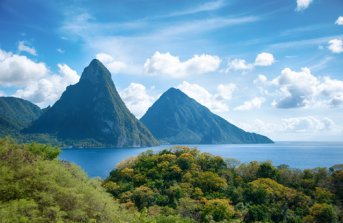
St. Lucia’s twin towering peaks, the Pitons, and prime landscape soar out of the Caribbean Sea to great altitude. The Gros Piton (The larger peak) to the south is 798 meters tall, and the Petit Piton (the Smaller piton) is 750 meters. The pitons were formed by volcanic activity about 200 to 300 generations ago, both of the pitons are considered to be difficult to climb. Divers also explore the pitons as underwater cliffs. However, most visitors simply view them for their picturesque beauty. The vibrant fishing village of Soufriere offers one of the best views of the twin Pitons.
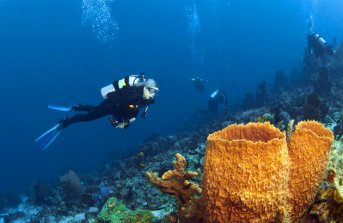
Anse Chastanet coral reef features a treasure chest of marine life across vast depths. On a plateau of two to eight meters, divers get the chance to see colourful sponges, boulder corals, soft corals and brain corals. Frogfish inhabit a large nearby cave, and divers may see many different types of fishes in the coral gardens, including goatfish, parrotfish, wrasse, barracudas and chromis. The edge of the plateau is a wall that descends 46 meters to a lace coral ecosystem dominated by crabs and eels. Plate coral starts below 30 meters. Above the surface, is a protected beach with breathtaking vistas of the Pitons.
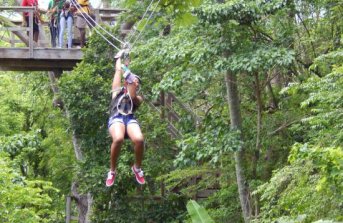
Overlooking Soufrière Bay, Morne Coubaril Estate is a well-known stop on the tourist circuit. The estate is a beautiful working plantation producing cocoa, coconuts and manioc. Zip-lining in view of the Pitons is the most amazing activity that is offered by the estate, but visitors can also enjoy hosted tours of the plantation, its tropical gardens and an imitation of an authentic village. Guides show the processing of coconut for food products and demonstrate how sugar cane syrup, cocoa, coffee, and manioc are produced. After the tour guests can get to enjoy local cuisine at the plantation’s restaurant.
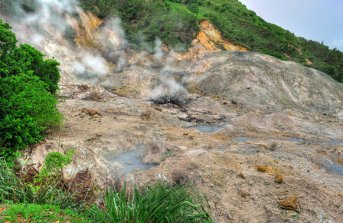
Named after the sulphur that was formerly mined at the site, Mount Soufriere (also known as Sulphur Springs Park) is the most active geothermal area in the Lesser Antilles. A trail traverses the edge of the 274-meter crater making Mount Soufriere a rare "drive-through" volcano. Though St. Lucia's last volcanic eruption occurred over 40 generations ago, this volcanic vent still continues to emit sulphur into the air and heat pools of water above boiling point. Visitors can view the bubbling pools and hissing fumaroles from observation stations, and indulge in some nearby therapeutic springs.
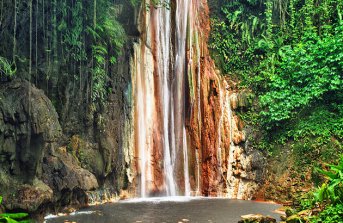
The Diamond Falls section the Soufrière Estate features three amazing attractions: we-conceived gardens, a spectacular waterfall coloured by mineral deposits, and healing mental hot spring baths that were originally built King Louis’ the XVI troops of France. The gardens were created among cocoa, coconut, mahogany and red cedar trees with shrubs and tropical flowers from all around the world. Within the gardens, visitors will find educational demonstrations of local fruits and vegetables such as soursop, christophine, and dasheen. For a small admission, visitors can also use the relaxing outdoor pools or private bathhouses. Another attraction on the site of this iconic estate is the old mill and waterwheel where guests are served a Caribbean buffet.
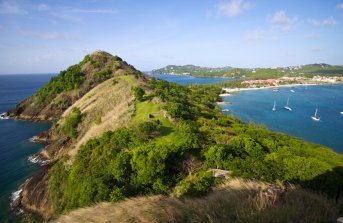
Pigeon Island National Park, across from Rodney Bay is one of the most important historic attractions in St. Lucia. Strategic hideouts on the island allowed the British to oversee the movements of the French troops in Martinique during the struggle for the capture of St. Lucia. Today island is connected the mainland by a causeway and visitors can explore the lookout pointed enjoy scenic views of St. Lucia’s north-west coast. The island also houses ruins of the military buildings that were used during battles between the French and English, an interpretation centre displaying the island’s interesting history, two white sand beaches and a restaurant.
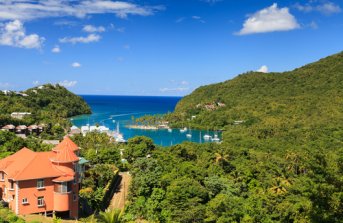
Marigot Bay is arguably the most beautiful bay in all of St. Lucia; it is best viewed from a vista point on the road between the main Caribbean coastal route and the bay itself. Lush foliage dominates the hillsides with pretty palm-fringed beaches below, and yachts bob on the bay’s sky-blue waters. The harbour is so deep and protected that the British were rumoured to have hidden here from the French by covering their masts with palm fronds. Marigot Bay was also the setting for the famous 1967 movie Doctor Doolittle, a claim to fame that has left its mark on the names of some of the local establishments permanently. Water shuttles carry people across the bay to resorts on the opposite side.
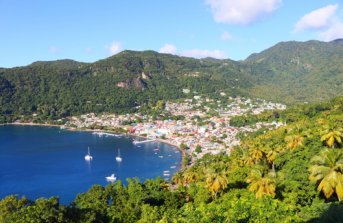
The vibrant fishing village of Soufrière is encompassed a beautiful bay and is best viewed from an overlook from the main road to Vieux Fort. The town was established in 1745 with its most outstanding features being the town square, some to the church of the Assumption of the Blessed Virgin Mary, and the countless buildings with filigreed balconies and tin roofs. The town was the site of the guillotine that was erected during the time of the French Revolution in 1780. Many plantation owners and their families were sentenced here. The Wharf, which is located a block away from the town square, is the stopping point for many excursion cruises. The 1989 courthouse adjacent the wharf Soufrière’s main claim to fame is that Josephine, the wife of Emperor Napoleon Bonaparte, was born here in 1763.
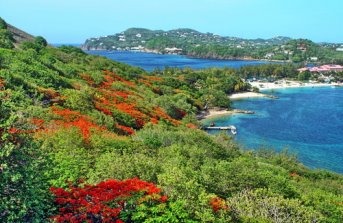
On the Gros Islet northern end of St Lucia, Rodney Bay is a tourist magnet in St. Lucia with its scenic crescent-shaped beach peppered by resorts, shops and restaurants. Encompassed to the North by Pigeon Island National Park and Labrellotte Point to the South, this sheltered bay is a popular spot for boating. The Rodney Bay Marina is one of the best equipped in the eastern Caribbean with many waterspouts to offer. Beautiful homes freckle the hills surrounding the Bay, and St. Lucia’s biggest shopping mall in the area. Nearby is one of St. Lucia’s most popular stretches of beach, Reduit Beach.
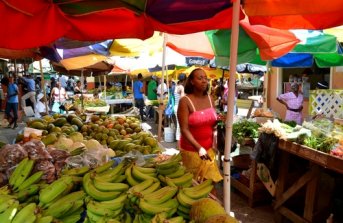
The buzzing Castries market, at the most easterly point of Castries harbour, is a great place to experience a slice of local St. Lucian life. Goods on sale range from handicrafts to locally produced fruits and vegetables. Shoppers can buy batiks, gift baskets of spices, banana ketchup oils, hot-pepper sauces, hand-made brooms, woodcarvings and the local collector's items. While the market is open every day, the most active day is Saturday.